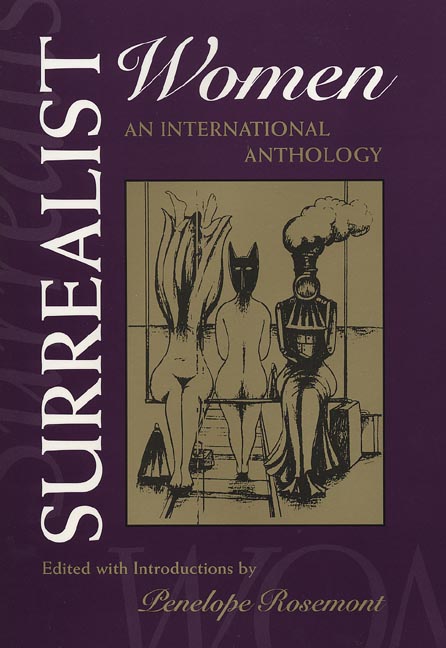Penelope Rosemont (ed.): Surrealist Women: An International Anthology (1998)
Filed under book | Tags: · art criticism, surrealism, women

“Beginning in Paris in the 1920s, women poets, essayists, painters, and artists in other media have actively collaborated in defining and refining surrealism’s basic project—achieving a higher, open, and dynamic consciousness, from which no aspect of the real or the imaginary is rejected. Indeed, few artistic or social movements can boast as many women forebears, founders, and participants—perhaps only feminism itself. Yet outside the movement, women’s contributions to surrealism have been largely ignored or simply unknown.
This anthology, the first of its kind in any language, displays the range and significance of women’s contributions to surrealism. Letting surrealist women speak for themselves, Penelope Rosemont has assembled nearly three hundred texts by ninety-six women from twenty-eight countries. She opens the book with a succinct summary of surrealism’s basic aims and principles, followed by a discussion of the place of gender in the movement’s origins. She then organizes the book into historical periods ranging from the 1920s to the present, with introductions that describe trends in the movement during each period. Rosemont also prefaces each surrealist’s work with a brief biographical statement.”
Introductions by Penelope Rosemont
First published by Athlone Press, London, 1998
Publisher University of Texas Press, Austin, 1998
Surrealist Revolution series
ISBN 029277088X 9780292770881
lvii+516 pages
Review: Bertha Husband (ATC, 1999).
PDF (19 MB, updated on 2017-11-21)
Comment (0)David Novak: Japanoise: Music at the Edge of Circulation (2013)
Filed under book | Tags: · aesthetics, ethnomusicology, feedback, improvised music, japan, listening, music, music criticism, music history, musicology, noise, performance, technology

“Noise, an underground music made through an amalgam of feedback, distortion, and electronic effects, first emerged as a genre in the 1980s, circulating on cassette tapes traded between fans in Japan, Europe, and North America. With its cultivated obscurity, ear-shattering sound, and over-the-top performances, Noise has captured the imagination of a small but passionate transnational audience.
For its scattered listeners, Noise always seems to be new and to come from somewhere else: in North America, it was called ‘Japanoise.’ But does Noise really belong to Japan? Is it even music at all? And why has Noise become such a compelling metaphor for the complexities of globalization and participatory media at the turn of the millennium?
In Japanoise, David Novak draws on more than a decade of research in Japan and the United States to trace the ‘cultural feedback’ that generates and sustains Noise. He provides a rich ethnographic account of live performances, the circulation of recordings, and the lives and creative practices of musicians and listeners. He explores the technologies of Noise and the productive distortions of its networks. Capturing the textures of feedback—its sonic and cultural layers and vibrations—Novak describes musical circulation through sound and listening, recording and performance, international exchange, and the social interpretations of media.”
Publisher Duke University Press, Durham, 2013
Sign, Storage, Transmission series
Creative Commons BY-NC-ND 3.0 License
ISBN 9780822353799, 0822353792
x+292 pages
via author
Reviews: Shaun McKenna (Japan Times, 2013), Scott McLemee (Inside Higher Ed, 2013), Nana Kaneko (Ethnomusicology Rev, 2014), Andrés García Molina (Current Musicology, 2014), Max Ritts (Society+Space, 2014), Jonathan Service (Japan Forum, 2014), Rosemary Overell (Perfect Beat, 2014), Patrick Valiquet (Popular Musicology, 2014), Owen Coggins (Harts & Minds, 2014), Seth Mulliken (Sounding Out!, 2014), E. Taylor Atkins (Asian Music, 2015), Shelina Brown (Notes, 2015), Jennifer Milioto Matsue (Am Anthropologist, 2015), Carolyn S. Stevens (Am Ethnologist, 2015), Christopher Tonelli (Sound Studies, 2016), Benjamin Harley (Enculturation, 2016), Etienne RP (2017).
Book website, with supplemental media
Publisher
WorldCat
The Social Life of Artistic Property (2014)
Filed under book | Tags: · art, collaboration, labour, property

“In the wake of Occupy Wall Street, 12 artists gathered for 20 meetings over two and a half years, discussing property both physical (studios and homes) and artistic. Rather than present raw transcripts of their conversations, the authors individually or collaboratively penned chapters on relevant issues. We get historical case studies alongside a host of topical issues affecting artists’ abilities to work, such as the French droit de suite, the right to resale royalties of artists and their heirs. Michael Mandiberg offers a significant oral history of 135 Rivington Street, a collectively artist-owned building purchased in 1981 by a group of art school alumni, a virtual impossibility in today’s real estate game.” (ArtNews)
By Pablo Helguera, Michael Mandiberg, William Powhida, Amy Whitaker, and Caroline Woolard
Self-published, 2014
Creative Commons BY-SA License
ISBN 9780984475025
110 pages

